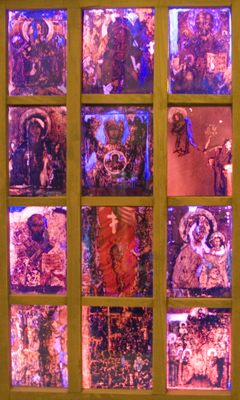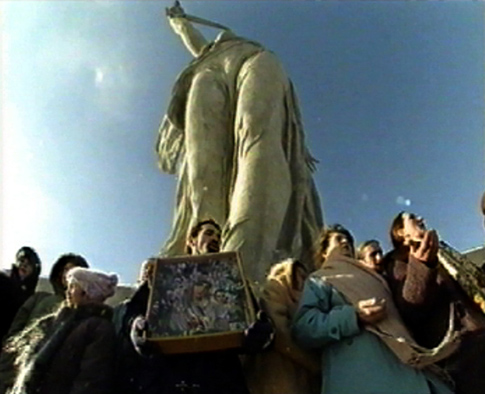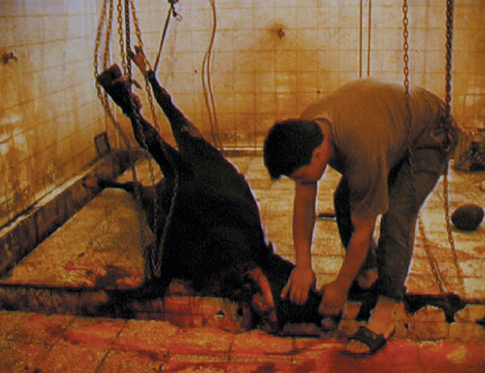
Sacred Reality #1, 2008
The Russian poet and musician Hermes Zygott has submitted old, damaged Byzantine icons to a loving reanimation. What Walther Benjamin described as the loss of aura here refers above all to the original artworks, which were previously elevated into cultic objects but are now elbowed aside by the technical reproduction of images in Modernity. As icons have always defined themselves by being worshipped in their surroundings, Hermes Zygott tries to restore the aura of these neglected models technically and fetch them out of oblivion back into the focus of contemporary admiration: installed on colourful light-boxes, they now shine out, to the accompaniment of an electronic reinterpretation of Monteverdi's Vespro della Beata Vergine, in a new – electrical – light.
Hermes Zygott, * 1964 in St. Petersburg (formerly Leningrad, UDSSR),
lives and works in Moscow (RUS)

Hermes Zygott
Orthodox XXI Century, 2008
Russian Monstrosities, 2008
Sacred Reality #1, 2008
Light boxes, wooden frame, sound
90 x 58 cm, 80 x 40 cm, 68 x 55 cm
music: reinterpretation of Monteverdis
Vespro della Beata Vergine (1610)
Guns P. Holman and Hermes Zygott, 2008
courtesy RNA Foundation
|
|

Der See der Vergessenheit / Lake of Oblivion, 2000
In his piece Der See der Vergessenheit / Lake of Oblivion the artist Vadim Zakharov, a member of the circle of Moscow Conceptualists, projects a video on sects and modern "prophets." The translated text accompanying the video can be listened to on headphones in Latin, Old Greek and in the Gothic language. Zakharov demonstrates in this work ironically, how sects are utilizing oblivion as a drug and in addition he refers to, by means of the dead languages, an omnipresent culture of forgetting. His topic is, on the one hand, the conscious manipulation of memory by religious groups, and, on the other, the abundance of information and images in the media, leading to "waves of amnesia," to a constant deleting and replacing of information.
Vadim Zakharov, * 1959 in Duschanbe (formerly UDSSR), lives and works in Cologne (D)
 Vadim Zakharov, Der See der Vergessenheit / Lake of Oblivion, 2000 Vadim Zakharov, Der See der Vergessenheit / Lake of Oblivion, 2000
video installation (colour, sound)
30 min., loop
courtesy Vadim Zakharov
|

The Sleep of Reason. This Blood Spilled in My Veins, 2002
The video The Sleep of Reason. This Blood Spilled in My Veins documents the ritual slaughter of two cows and two sheep, which Jalal Toufic sets in direct contrast to sequences of people sleeping. "The organic dying of a (resurrectable) human is as nothing compared to that of an animal, exemplarily of a bull in a corrida; the only phenomenon that equals in intensity is the resurrection of a human...," so Toufic comments. Attempting a religious exaltation and glorious fulfilment of basic existence through rituals of penitence, martyrdom and sacrificial death in the religious traditions of Islam are the central motifs of his literary and philosophical texts and films.
Jalal Toufic, * 1962 Beirut (RL), lives and works in Beirut (RL)
 Jalal Toufic, The Sleep of Reason. This Blood Spilled in My Veins, 2002 Jalal Toufic, The Sleep of Reason. This Blood Spilled in My Veins, 2002
video (colour, sound)
32 min., loop
courtesy Jalal Toufic
|
|



